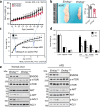The effects of ENDOG on lipid metabolism may be tissue-dependent and may not require its translocation from mitochondria
- PMID: 39169002
- PMCID: PMC11339265
- DOI: 10.1038/s41467-024-51447-x
The effects of ENDOG on lipid metabolism may be tissue-dependent and may not require its translocation from mitochondria
Conflict of interest statement
The authors declare no competing interests.
Figures



Similar articles
-
Reply to: The effects of ENDOG on lipid metabolism may be tissue-dependent and may not require its translocation from mitochondria.Nat Commun. 2024 Aug 21;15(1):7122. doi: 10.1038/s41467-024-51448-w. Nat Commun. 2024. PMID: 39168974 Free PMC article. No abstract available.
-
Overexpression of SOD1 in transgenic rats attenuates nuclear translocation of endonuclease G and apoptosis after spinal cord injury.J Neurotrauma. 2006 May;23(5):595-603. doi: 10.1089/neu.2006.23.595. J Neurotrauma. 2006. PMID: 16689664
-
Mitochondrial BNIP3 upregulation precedes endonuclease G translocation in hippocampal neuronal death following oxygen-glucose deprivation.BMC Neurosci. 2009 Sep 8;10:113. doi: 10.1186/1471-2202-10-113. BMC Neurosci. 2009. PMID: 19737385 Free PMC article.
-
Interaction of Mitochondria with the Endoplasmic Reticulum and Plasma Membrane in Calcium Homeostasis, Lipid Trafficking and Mitochondrial Structure.Int J Mol Sci. 2017 Jul 20;18(7):1576. doi: 10.3390/ijms18071576. Int J Mol Sci. 2017. PMID: 28726733 Free PMC article. Review.
-
Mitochondria as the target of the pro-apoptotic protein Bax.Biochim Biophys Acta. 2006 Sep-Oct;1757(9-10):1301-11. doi: 10.1016/j.bbabio.2006.05.032. Epub 2006 May 27. Biochim Biophys Acta. 2006. PMID: 16836974 Review.
References
Publication types
MeSH terms
LinkOut - more resources
Full Text Sources

